<< Previous | Displaying results 4291-4300 of 6776 for "" | Next >>
Ada Abrahamer kept a diary from September 1939 until March 1946, though only the pages from 1944-1946 survived. Ada’s diary documents her experiences as a young Jewish woman in German-occupied Poland. German authorities imprisoned Ada in the Krakow ghetto and several forced labor and concentration camps, including Auschwitz. In later entries, she describes her liberation and life after the war. In this entry, Ada describes her journey from Plaszow to Auschwitz in October 1944.
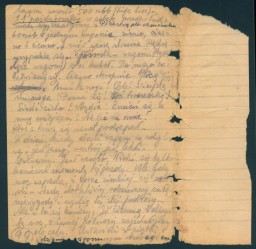
Ada Abrahamer kept a diary from September 1939 until March 1946, though only the pages from 1944-1946 survived. Ada’s diary documents her experiences as a young Jewish woman in German-occupied Poland. German authorities imprisoned Ada in the Krakow ghetto and several forced labor and concentration camps, including Auschwitz. In later entries, she describes her liberation and life after the war. In this entry from October 1944, Ada describes the selection process at Auschwitz-Birkenau.
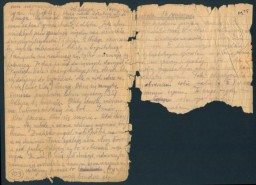
Identification papers issued to Erika Tamar stating that she was born in Vienna on June 10, 1934. Erika was one of the 50 children rescued by Gilbert and Eleanor Kraus.
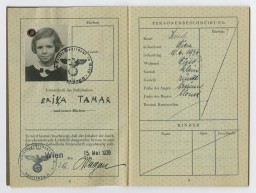
A chart detailing physical characteristics of a Romani (Gypsy) individual, c. 1938. Dr. Robert Ritter and his team created extensive family trees and genealogical charts in order to identify, register, and classify all Romani people living in Nazi Germany. During the Nazi era, Dr. Robert Ritter was a leading authority on the racial classification of people pejoratively labeled “Zigeuner” (“Gypsies”). Ritter’s research was in a field called eugenics, or what the Nazis called “racial…
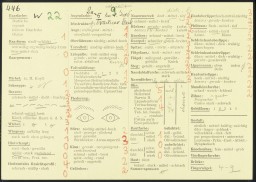
A genealogical chart of the Franz family, composed of identification photographs taken by the criminal department of the Aschaffenburg Identification Service [Erkennungsdienst]. Bavaria, Germany, 1942. This particular Romani family tree includes notes labeling individuals as "vagrants," "invalids," or "habitual criminals." Racial hygienists would collect genealogical documents or create family trees in order to identify, register, and classify all Romani people living in Nazi Germany. Roma (pejoratively…
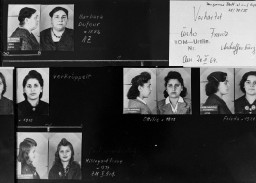
Diagram of the Hodonín u Kunštátu (Hodonin bei Kunstadt) camp in the Protectorate of Bohemia and Moravia (Czech Republic). Before it was converted into a Zigeunerlager (“Gypsy camp”) in 1942, it served as a penal labor camp. Translation of key: Scale 1:500 Sleeping quarters Sleeping quarters Mess-hall Infirmary Offices, prison Living quarters for guard staff Economic/Agricultural Building Latrine Well Mess-hall for guard staff Pens for guard dogs
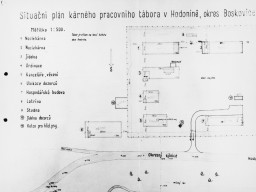
During World War II, people often used false identities and forged identity documents to evade Nazi authorities. False identities were essential for resistance fighters, aid workers, and Jews hoping to pass as non-Jews. Creating high-quality, convincing forgeries required dozens of people to work together clandestinely. It also required sophisticated photography and printing equipment. For Jews passing as non-Jews, acquiring forged documents could mean the difference between life and death. This forged…
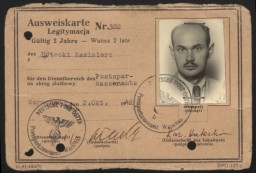
During World War II, people often used false identities and forged identity documents to evade Nazi authorities. False identities were essential for resistance fighters, aid workers, and Jews hoping to pass as non-Jews. Creating high-quality, convincing forgeries required dozens of people to work together clandestinely. It also required sophisticated photography and printing equipment. For Jews passing as non-Jews, acquiring forged documents could mean the difference between life and death. During World…

During World War II, people often used false identities and forged identity documents to evade Nazi authorities. False identities were essential for resistance fighters, aid workers, and Jews hoping to pass as non-Jews. Creating high-quality, convincing forgeries required dozens of people to work together clandestinely. It also required sophisticated photography and printing equipment. For Jews passing as non-Jews, acquiring forged documents could mean the difference between life and death. This…
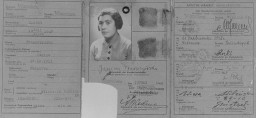
Kurt I. Lewin, who was Jewish, used this card while in hiding in a Ukrainian Greek Catholic monastery in German-occupied Poland (today Ukraine).
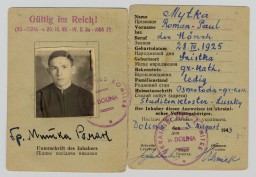
We would like to thank Crown Family Philanthropies, Abe and Ida Cooper Foundation, the Claims Conference, EVZ, and BMF for supporting the ongoing work to create content and resources for the Holocaust Encyclopedia. View the list of donor acknowledgement.